95th Evacuation Hospital Unit History
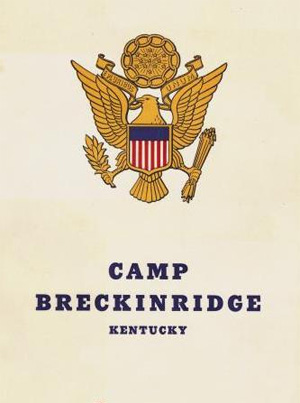
General information booklet illustrating Camp Breckinridge, Morganfield, Kentucky, Infantry Division Camp. US Army Post built in 1942, and originally created as an Infantry Training Center for up to 42,000 men. Also used during World War Two, 1943-1946, as a Prisoner of War camp for as many as 3,000 enlisted personnel of the German Armed Forces. Installation de-activated in 1949.
Introduction & Activation:
The 95th Evacuation Hospital, Motorized,was officially activated 25 August 1942 at Camp Breckinridge, Morganfield, Kentucky (Infantry Division Camp built 15 March 1942 for Infantry training, acreage: 36,070, troop capacity: 2,031 Officers and 42,092 Enlisted Men –ed).
The unit was officially based on the non-affiliated 74th Surgical Hospital constituted 21 December 1928, and activated 1 June 1941 at Fort Francis E. Warren, Cheyenne, Wyoming (Army Service Forces Training Center, acreage: 94,874, troop capacity: 665 Officers and 16,518 Enlisted Men –ed). The 74th Surg Hosp was re-organized and re-designated the 95th Evacuation Hospital on 14 August 1942 (in 1942, the Medical Department designed this kind of unit to perform the functions of either an Evacuation Hospital (T/O 8-580) or a Surgical Hospital (T/O 8-570) and indicated that it could replace either or both in the US Army medical service –ed). The unit’s official station in the Zone of Interior became Camp Breckinridge. The date was 19 September 1942. Unit Headquarters was set up as early as January 1943, after which date a number of Officers starting reporting for service with the hospital. The very first Officers to be appointed were:
Lt. Colonel Paul K. Sauer, MC (Commanding Officer, former Chief, New York Municipal Hospital)
First Lieutenant Blanche F. Sigman, ANC (Principal Chief Nurse)
First Lieutenant Carrie T. Sheetz, ANC (Assistant Chief Nurse)
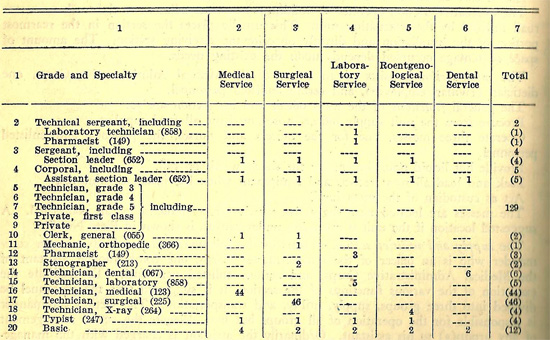
1942-dated table indicating suggested basic assignment of Enlisted personnel, for Professional Services of an Evacuation Hospital.
Another re-organization followed on 19 February 1943 whereby the unit was re-designated 95th Evacuation Hospital, Semimobile (later implemented in T/O 8-580, dated 23 Apr 43, and T/O 8-581, dated 25 Mar 44 –ed).
Organization:
The organization was originally based on T/O 8-232 (1941) consisting of 47 Medical Officers, 52 Nurses, and 318 Enlisted Men. Such types of units were usually assigned to a Field Army (10 per type of Army –ed) and received all classes of casualties, preparing them for further evacuation by rail. Their basic capacity was 750 patients, normally. In cases of emergencies, this capacity could be extended to 1200 patients, for a period not exceeding 3 days. The Evacuation Hospital was ideally set up 12 to 30 miles from the front, on a road from the front and on a railroad to the rear. The original organization was later reviewed, now being based on T/O 8-580 (1942), yet still consisting of 47 Officers, 52 Nurses, and 318 EM. Designations changed from Semimobile to Motorized. Following reorganizations took place, initially based on T/O 8-581 (1942) with an aggregate personnel strength of 39 Officers, 1 Warrant Officer, 48 Nurses, and 248 Enlisted personnel followed by T/O 8-580 (1943), with the same number of beds (750) numbering 48 Officers, 1 Warrant Officer, 53 Nurses, and 308 Enlisted Men, and later by T/O 8-581 (1944) limited to a bed capacity of 400, and consisting of 38 Officers, 1 Warrant Officer, 40 Nurses, and 217 EM.
The unit’s organic vehicles, never sufficient to move all personnel and equipment, initially numbered 10 (1942), eventually reaching 5 trucks and 3 trailers (1943) for the 750-bed version and 26 trucks (1944) plus 21 trailers for the 400-bed evacuation organization.
The Evacuation Hospital’s main functions included provisions for:
- facilities for major medical and surgical procedures in the care and treatment of all casualties, located as near to the front, as practicable
- facilities for the concentration of evacuees in such numbers and at such locations that mass evacuation by common carrier could be undertaken economically
- facilities for the beginning of definitive treatment as early as practicable
- triage and sorting of casualties under conditions most favorable for observation, and removal from the chain of evacuation of those fit for duty
- preparation of evacuees for extended evacuation to General Hospitals at some distance to the rear
Movement Overseas:
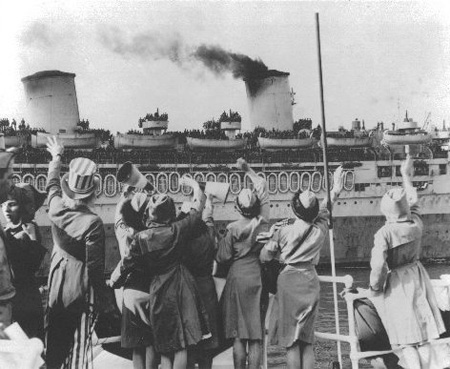
IIlustration of USAT “Mariposa” leaving the Zone of Interior for an ‘unknown’ destination overseas. This ex-Matson Lines luxury ocean liner (launched in 1931) was converted into a troopship serving the United States in the Far East, North Africa, and Western Europe, transporting military personnel and supplies during the war (1941-1945).
Following due processing, personnel and equipment boarded USAT “Mariposa” (ex-Matson Lines ocean liner launched in 1931 –ed) at the Brooklyn Navy Yard with destination North Africa (also on board were the 93d Evacuation Hospital, the 56th Evacuation Hospital, the 54th Medical Battalion, and members of the 99th Fighter Squadron, aka “Tuskegee” African-American airmen, as well as miscellaneous tank crews, engineers, and others –ed). The 400-bed 95th Evac Hosp departed New York POE 16 April 1943 and landed at Casablanca, French Morocco 24 April 1943.
Accommodations were crowded and although the ship had been originally designed a luxury liner, there certainly was no longer a trace of any luxurious accommodation. Bunks were set up in tiers and floors piled with equipment. Officers and Nurses had slightly more comfortable staterooms, nevertheless these were likewise crowded. It should be remembered that the transport carried 7,000 military personnel, including 3 complete Hospitals. Being a fast ship the USAT “Mariposa” would not sail in a convoy but cross the Atlantic alone.
North Africa:
The organization arrived in North Africa, debarking at Casablanca, French Morocco, 24 April 1943. After grouping, checking, and last minute instructions, the personnel disembarked in North Africa, for the majority a totally new world! The Nurses entrucked and were soon on their way to their temporary ‘home’, the International Grammar School. Officers and Enlisted personnel later used the same trucks to move to a tented camp set up in a fig orchard, about one mile outside town, where pyramidal tents awaited them.
The 95th continued to live in the field under tentage with no real ‘hospital’ job to do for over a month before receiving new orders to move to Oujda, (bivouacking enroute) an overpopulated and filthy town continuously at the mercy of the desert sands. It was here that the unit was to establish a hospital for the first time under actual combat operations.
During their stay at Oujda, one of the next-door neighbors was the 509th Parachute Infantry Battalion, which supplied the hospital with a regular number of ‘casualties’ suffered during training jumps. The paratroopers lived in a tent city, named “Camp Kunkle”. Days were like a furnace, with hot wind and fine dust ever present, dysentery plagued the men, and nights were cold. Needless to add that harsh environmental conditions affected morale.
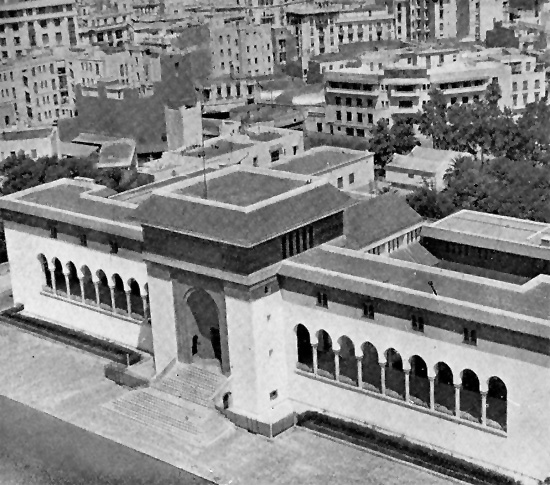
Aerial view of the “Palais de Justice”, Casablanca, French Morocco. Picture taken in 1943.
On the first day of operation, 109 patients were admitted. Only a few suffered from battle wounds, while the majority had malaria, injuries, or fever of an ‘unknown origin’.
Stations – 95th Evacuation Hospital
Oujda, French Morocco – 24 April 1943 > 4 July 1943 (serviced Fifth US Army)
Aïn-et-Turk, Algeria – 6 July 1943 > 16 August 1943 (handled Sicily casualties from “Operation Husky”)
The 95th Evac departed Oran, Algeria, 0915, 5 September 1943, aboard the Dutch vessel “Marnix van St. Aldegonde” (ex-Dutch liner, handed over to the British Government following the fall of Holland in May 1940 and converted into a troop ship in Singapore 9 July 1941 –ed) with destination Italy. The vessel was regarded as a ‘lucky’ ship for, out of 4 transports landing in Bizerte, Tunisia, in November 1942, she was the only one not sunk although escaping twenty-one near misses on her (this did unfortunately not last as she was sunk on 6 November 1943, off Algeria, carrying 3,000 troops from Liverpool to North Africa –ed). The Nurses did not travel with the men (Fifth US Army instructions ordered the Nurses to only land on D+3 –ed) but embarked on the HMS “Bedford” on their way to Bizerte, Tunisia. The unit’s vehicles were moved to Oran for waterproofing in view of the assault landing.
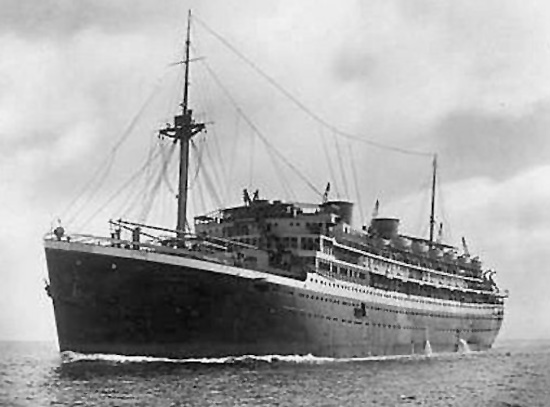
Illustration of troopship “Marnix van St. Aldegonde”. Staff and personnel of the 95th Evacuation Hospital (except the Nurses) embarked in Oran, Algeria, 5 September 1943, and traveled further on to Italy aboard this Dutch vessel.
Italy:
Being part of VI Corps, Fifth United States Army, the unit landed at Paestum, Italy, in support of “Operation Avalanche”, the Allied amphibious assault against Salerno on 9 September 1943. Personnel of the 16th and 95th Evacuation Hospitals had landed about noon on D-Day, but since their equipment was scattered and suitable installation sites were not yet available, the units could not open immediately. Within five hours after landing, 100 tons of medical supplies were unloaded during the night of 9-10 September; together with some 200 tons of organizational equipment belonging to the 16th and 95th Evac Hospitals. Personnel pertaining to the hospitals were responsible for collecting and sorting their own supplies, which were to be stored until sites became available. The 95th Evac had 250 of its 400 beds ready for occupancy by 0600 on 12 September (the 16th Evac would not go into operation before 15 Sept 43 –ed). The Nurses of both organizations had been aboard HMHS “Newfoundland” when she was bombed. Some suffered minor injuries but all lost personal belongings. After the raid, they were taken back to Bizerte, Tunisia, and did not rejoin their respective units until 25 September 1943.
Despite the number of hospitals and other medical units ashore, beds were at a premium, as many units were still awaiting their equipment which was either lost or delayed. The rapid buildup placed heavy demands on medical facilities. The 95th Evac CO, Lt. Colonel P. K. Sauer, reported: “…at times we were overfilled to such an extent that all cots were in use, other patients remained on the litters on which they had been brought to us in lieu of folding cots, and others were given 2 wool blankets to enable them to sleep on the ground. When the ward tents were filled to capacity, patients were laid on the outside along the tent walls with their heads inside and their bodies outside. One night even this method proved insufficient to take care of all the patients and 40 of them slept under the open sky between the tents. Fortunately the weather was balmy and dry …”
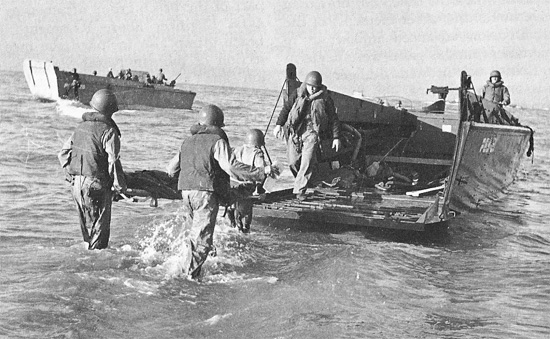
Litter bearers carrying a patient wade to a landing craft off Salerno Beach, 9 September 1943.
The weather did however not remain dry. A violent storm erupted during the night of 28 September and leveled a number of tents of the 16th Evacuation Hospital where 961 patients were being cared for, and damaged the installations run by the 95th. Fifth US Army hospitals gradually started moving into the combat zone with the Evacuation Hospitals leading the way.
The organization opened in Naples on 9 October 1943, while the 93d Evacuation Hospital moved hastily up to Avellino on 11 October. Plans for the Italian campaign called for the establishment of a medical base in the Naples area. This was taken care of by the activation of the 6665th Base Area Group (Provisional) with medical personnel drawn from ABS. In November the latter was reconstituted as the Peninsular Base Section (PBS). Although both cholera and typhus had been reported before its capture, American Officers found the general health situation in Naples good. Sanitation was the major problem but the water supply was quickly restored by the Engineers. Pending arrival of fixed medical installations, hospitalization and medical service was provided by the 307th Airborne Medical Company and the 162d Medical Battalion, with the 95th Evacuation Hospital taking over October 9 assisted by the 3d Convalescent Hospital from October 12, 1943.
Various Italian military and civilian hospitals as well as school buildings having been selected for medical use, the most suitable area for additional fixed medical installations appeared to be the “Mostra Fairgrounds” at Bagnoli, three miles from the center of Naples. The site contained numerous spacious buildings, with water, sewerage, power and good road and rail connections. This resulted in the organization of a provisional Medical Center, which was to comprise: 182d Station Hospital – 3d Convalescent Hospital – 4th Medical Supply Depot – 225th Station Hospital – 23d General Hospital – 21st General Hospital – 45th General Hospital – 53d Station Hospital – 37th General Hospital.
Heavy casualties coupled with transportation difficulties over muddy and congested roads required more hospitals in the combat area. The organization was therefore instructed to depart Naples and move on to a site beyond the Volturno River, northwest of Capua. It moved on 28 November, to be soon joined by the 10th Field Hospital. Being designated for the Anzio operation, both the 93d and 95th Evacuation Hospitals were closed early January 1944.
Few miles were to be gained in December at a high cost in Allied casualties. Because of delays caused by weather and bitter fighting a new plan was issued for a seaborne flanking movement to Anzio, with VI Corps being assigned this operation. Orders from the Fifteenth Army Group were issued 2 January 1944.
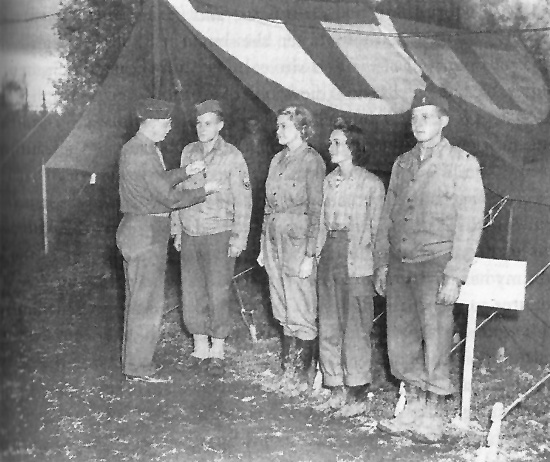
Naples, October 1943. Lt. Colonel Paul K. Sauer (CO, 95th Evacuation Hospital) awards “Purple Hearts” to hospital personnel, following the Naples Post Office tragic explosion of 10 October 1943, caused by a bomb planted by the withdrawing Germans, which blew up the building, destroying it and nearby vehicles, and killing a number of Allied personnel.
The coming of the New Year was duly celebrated at Capua, Italy, after one of the most intensive and arduous periods of activity, 1943 closing with only 456 patients in the hospital’s wards. Around 0400 hours, 1 January 1944 a gale wind roused the personnel from their beds to try and keep tentage erect and equipment and personnel dry. Notwithstanding all efforts, several tents were ripped into shreds and a few even came down poles being torn from the canvas and pins being pulled out of the ground. Respite only came in the afternoon.
Since very few patients came through, suspicions were aroused of some impending move. After receiving the necessary orders on 4 January 1944, all patients had been evacuated and packing of equipment was begun. The hospital was to close station and prepare vehicles and equipment for an important amphibious operation. By 8 January, the movement to the staging area at Caivano had been completed and all Nurses detached and sent to the Bagnoli staging area where they were to remain until such time as the tactical situation would permit. Canvas tentage was adorned with large red crosses, vehicles were waterproofed, and everything was checked over and over again. On 19 January 1944, automotive transportation was loaded and the next day personnel boarded LST # 163 and anchored at Naples harbor. The 95th Evac Hosp was part of the invasion forces sailing out of Naples before dawn at 0500, 21 January 1944.
After joining the convoy, the personnel was thoroughly briefed and the destination revealed. The organization was to participate in “Operation Shingle”, Allied landings at Anzio, Italy, starting 22 January 1944. Personnel and equipment unloaded on Green Beach at 1300 hours, 23 January. After some reconnaissance for an appropriate site, the 95th Evac moved to a park halfway between Anzio and Nettuno adjoining an Infant Sanatorium. Although ideally located, enemy artillery shells frequently passed over the site aimed at the ships in nearby Anzio harbor and this dangerous situation could not be overlooked. Patients gradually became uneasy, and personnel felt unsafe. Work was not easy as a number of men and patients were wounded by flak falling through the tents. Air raids became more frequent, during night and day, and one day a bomb was dropped within only 100 yards from the hospital, almost destroying an Engineer map depot, resulting in rocks and mortar falling into the Officers’ quarters area. The unit’s Nurses joined the hospital on 28 January 1944 and performed their duties with admirable courage, notwithstanding the trying and dangerous circumstances. Evacuation proved difficult and often trucks and ambulances loaded with patients had to return from the beaches, causing overcrowding at the facility.
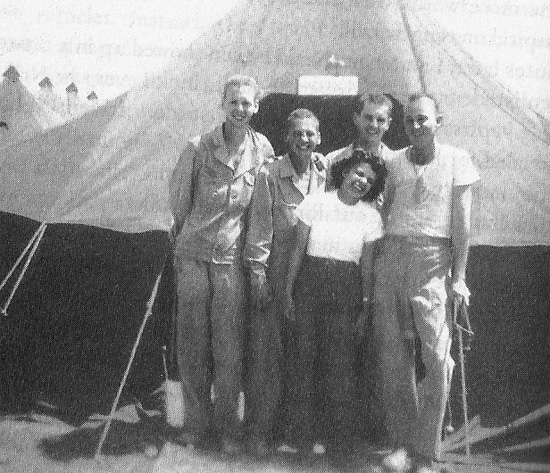
95th Evacuation Hospital personnel in front of their M-1934 pyramidal tent, Anzio Beachhead, Italy. This photo was probably taken at the organization’s first location, somewhere between Anzio and Nettuno, after 28 January 1944.
After one week of operation at the site it became evident that the tactical situation was not improving and on 30 January it was decided to move to the east of Nettuno where a US hospital area was being organized to hold and group all major installations. The problem was the lack of choice as the enemy contained the beachhead. After evacuating its 442 patients the 95th moved to the new site before dark, setting up, and receiving patients at 1500, 31 January 1944. During the past period, the hospital cared for 467 surgical and 296 medical cases, of which 322 were battle casualties. The trouble was that the new area was not much safer than the previous one, totally at the mercy of the enemy’s observation and the rules applying to the Geneva Convention.
Being surrounded by military installations (airfield, artillery, radar station, gasoline dump) long-range enemy artillery shells constantly whistled overhead with one gun being known as the “Anzio Express”. Most personnel could get no sleep being awake most of the time either by the noise of the enemy shells or by the shaking of the ground under them. Following the new setup battle casualties amounted to 75% of all admissions.
Tragedy struck on 7 February 1944. With about 400 patients in the hospital, loaded ambulances coming in with freshly wounded, and the operating rooms, shock wards, and x-ray sections working at full capacity, at about 1545, an enemy plane dived, chased by two British Spitfires. Before anyone could realize what was happening, five anti-personnel bombs had been dropped on a corner of the hospital area causing death and damage to personnel and equipment. Within an hour the dead had been removed, the wounded transferred to neighboring installations, surgical cases evacuated, and medical function again set in operation. Following a visit by Brigadier General Frederick A. Blesse (Surgeon NATOUSA) and Brigadier General Joseph I. Martin (Surgeon, Fifth US Army), arrangements were made to effect an exchange of serviceable property and personnel with the 15th Evacuation Hospital from Riardo, Italy. The administrative section had been particularly hard hit. In spite of all the hardships, the unit handled 139 admissions and 152 dispositions. Having finally arrived, the 15th Evac took over on 10 February. The following day, what remained of the 95th returned to Riardo to take over the equipment of the 15th Evac and re-organize and re-equip.
Before departure however, the Germans decided to give the organization a royal send-off by dropping artillery shells in and around the area, causing personnel casualties to the 33d Field Hospital and damaging some of their equipment. More anxious and unpleasant hours were spent at the docks waiting for an LST that was experiencing some trouble. In 11 days of operation, 1391 patients were cared for, of which 740 were surgical and 651 medical cases. The next three weeks were spent in obtaining new equipment and replacements. Away from any combat, medical services were now provided to the 85th Infantry Division training in the area.

Surgical personnel at work on the Anzio Beachhead. Picture taken January-February 1944.
Bombing Raid of the 95th Evacuation Hospital 1545 hours, 7 February 1944, Anzio Beachhead:
A German plane (type undetermined) dropped 5 antipersonnel bombs within the area of the hospital. Eye witnesses stated that the aircraft was being tailed by, and was the target of a friendly (British) fighter. Small caliber gun fire landed in the area without damage. The bombs fell in the following areas:
- 10 feet from Headquarters tent
- on the Evacuation tent
- 4 feet from the Pre-Operative tent
- midway between the Receiving tent and Ward # 1
- on the large canvas Red Cross marker spread out 50 feet from the Hospital’s Laboratory
Hospital personnel casualties were:
- killed – 2 Officers, 3 Nurses, 1 Red Cross worker, 16 Enlisted Men
- wounded – 9 Officers, 1 Warrant Officer, 4 Nurses, 36 Enlisted Men
Patient personnel casualties were:
- killed – 4 Patients
- wounded – 10 Patients
Other personnel casualties were:
- killed – 2 Enlisted Men
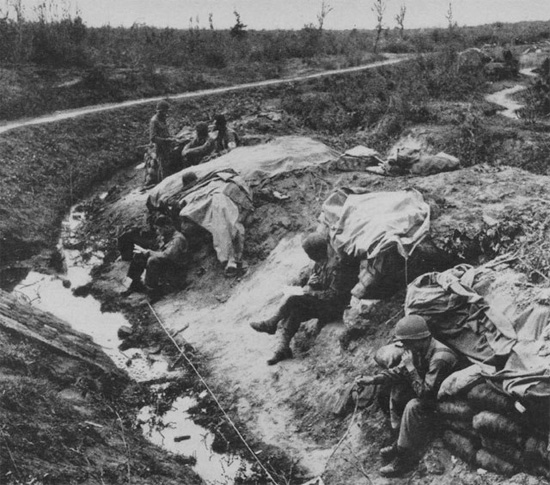
Illustration showing the difficult and poor living conditions on the Anzio Beachhead.
Property Damage, Tentage damaged or completely destroyed:
- 29 Ward tents
- 2 Surgical Operating tents
- 6 Pyramidal tents
- 3 Storage tents
- 1 Large Wall tent
Miscellaneous Equipment Damage:
- numerous small items, such as tables, chairs, stoves, typewriters, complete X-Ray equipment
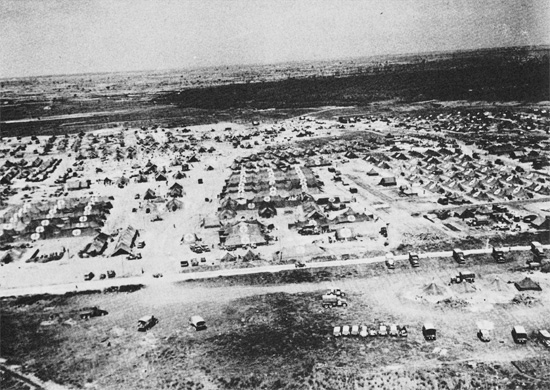
Partial aerial view of the American hospital area on the Anzio Beachhead, Italy. Picture taken course of January-February 1944.
Serious casualties were removed and transferred to the 33d Field Hospital and the 56th Evacuation Hospital. Pre-op patients, not injured in the raid, were moved to the 56th and 93d Evacuation Hospitals for operation and treatment. The 95th Evac continued to function as a medical installation and remained at a capacity of 350 beds, due to damage of Wards # 1 and 2. No surgical cases were however received due to the lack of X-Ray facilities, destroyed in the bombing. The following personnel were commended verbally (they helped remove the dead and evacuate patients to other hospitals) by the acting unit commander, Lt. Colonel Hubert L. Binkley, MC:
Captain Henry A. Korda
Captain Henry A. Luce
Technician 5th Grade George J. Schuerman
Private First Class Donald E. Druck
Private Wesley Tanner
On 13 March 1944, following the regrouping of Allied Armies in Italy, the 95th Evac moved to a new site in the vicinity of Carinola. During this period the Legion of Merit was conferred to Captain Thomas O. Matthews, the Detachment Commander, and on First Sergeant Frank B. Druschel for their services during the Salerno landings. At the same time, the Bronze Star Medal was awarded to Sergeant Major Richard C. Seymour and Technical Sergeants Nelson R. Studer, Richard E. Russell and Francis M. Hopkins. A similar award (posthumous) was made to Technician Third Grade Simon C. Smith.
On 24 April 1944 the organization celebrated its FIRST Anniversary of overseas service. After dinner and dance, Major General J. I. Martin presented Lieutenant Colonel Hubert L. Binkley with the Bronze Star Medal for meritorious service at the Anzio Beachhead after the CO had been evacuated because of wounds received in the bombing. Thereafter another Unit Commendation came through from the CG, Fifth United States Army.
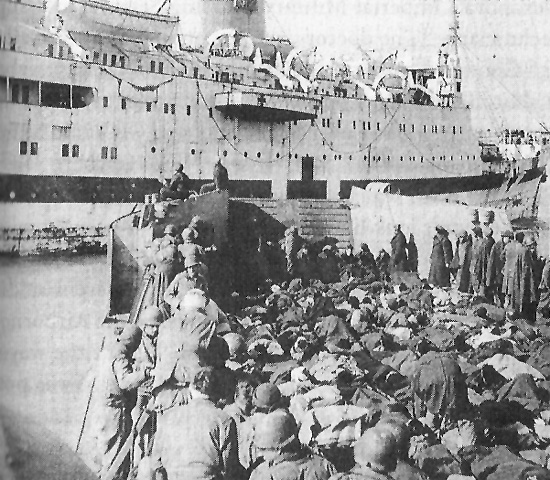
American wounded on board LCT landing craft are being transferred to HMHS “Leinster”, off Anzio, Italy, February 1944.
By early May, the 95th was again functioning as a wholesome and unified command with esprit de corps and morale running high, and the effects of the Anzio catastrophe ancient history. After 10 days the front had moved so rapidly, that it was necessary to move further north. Around 23 May 1944 a move was made to Itri and by noon of the following day patients were being operated upon again. A total of 1241 patients passed through the installation. Itri and the next stop in the vicinity of Cori were both of short duration. However, both were marked by intensive activity. Communication remained a problem and all reports had to be transmitted by messengers. Meanwhile Rome had fallen 4 June 1944, and the hospital was many miles behind the front. On 12 June clearance was given for the organization to move 111 miles to Montalto, seventy miles north of Rome.
The move was made in 3 echelons and was scheduled as follows:
FIRST Echelon basic installation (18 trucks + 8 trailers)
including 5 wards, receiving section, x-ray section, pre and post-operative section, operation section, medical supplies, pharmacy & laboratory section, kitchen, dental section, utilities, pyramidal tents, reserve
SECOND Echelon (17 trucks + 8 trailers)
including 5 wards, headquarters & evacuation, officers’ & nurses’ baggage, officers’ & nurses’ tentage, stoves, officers’ & nurses’ mess sections, officers & nurses, kitchen, medical supply section
THIRD Echelon (16 trucks + 8 trailers)
including enlisted men’s section, unit supply section, chapel, medical supplies, kitchen, enlisted men’s tents and baggage, utilities, ARC, reserve

Personnel contemplating the bomb damage to the 95th Evacuation Hospital on the Anzio Beachhead. The tragic bombing of 7 February 1944 caused 28 deaths, of which 22 were hospital personnel. Bomb fragments ripped through the administrative, receiving, and operating room tents, killing, wounding, and maiming personnel at work and patients.
It was considered that if movement was made by echelon, the unit could easily start functioning upon arrival of the second echelon! The movement by echelons according to the above plan, proved to be the most efficient and least time consuming.
1672 patients were processed while at Montalto, but overall work was light. During this period the unit was re-organized under the amended T/O & E 8-581, dated 25 March 1944, which caused a few changes including the loss of some personnel. In view of another forthcoming amphibious operation, the 95th was relieved of assignment to the Fifth US Army and re-assigned to Allied Force Headquarters (AFHQ). Because of its experience and past performance it had been chosen to participate in yet another big operation.
During their stay in Italy, a total of 2117 surgical operations were performed, resulting in 32 deaths.
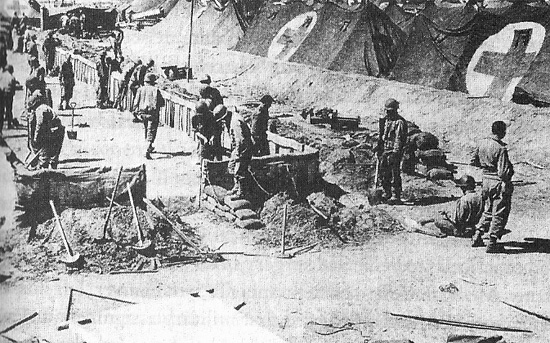
Following the tragic bombing incident, extensive protective measures were undertaken on the Anzio Beachhead by end February 1944. Illustration showing Engineers at work digging in the tents to protect them as much as possible from shrapnel and bomb fragments, following instructions from Major General Lucian K. Truscott, Jr., Commanding General VI Corps.
By 18 July 1944, all personnel and equipment had arrived at the Sparanise staging area. Despite repeated protests, the organization’s vehicles were not to accompany the hospital during its landing operation (only 3 vehicles were allowed). On 9 August all personnel embarked on 2 LCIs; 5 Officers and all EM on one, and the remaining Officers and 3 Enlisted Men on another one. The ships sailed from Pozzuoli at 1500 hours to Salerno and dropped anchor in Salerno Bay for the night. On 12 August, the convoy departed for the island of Corsica, entering Ajaccio’s harbor in wait for other convoys to arrive.
Stations – 95th Evacuation Hospital
Paestum, Italy – 12 September 1943 > 7 October 1943
Naples, Italy – 9 October 1943 > 28 November 1943
Capua, Italy – 28 November 1943 > 8 January 1944 (departed Capua for Caserta, in view of “Operation Shingle” – boarded LST 163 for Anzio, Italy 23 Jan 44)
Anzio, Italy – 24 January 1944 > 10 February 1944 (landed on Green Beach)
Riardo, Italy – 15 February 1944 > 4 March 1944
Carinola, Italy – 16 March 1944 > 21 May 1944
Itri, Italy – 24 May 1944 > 30 May 1944
Cori, Italy – 1 June 1944 > 10 June 1944
Montalto, Italy – 13 June 1944 > 10 July 1944 > (withdrawn from Fifth US Army)
Sparanise, Italy – 16 July 1944 > 18 July 1944 (staging area for preparation of “Operation Dragoon”)
Pozzuoli, Italy – 12 August 1944 (departed aboard 2 LCIs bound for Southern France)
Ajaccio, Corsica – 14 August 1944 (R-V point before landing in Southern France)
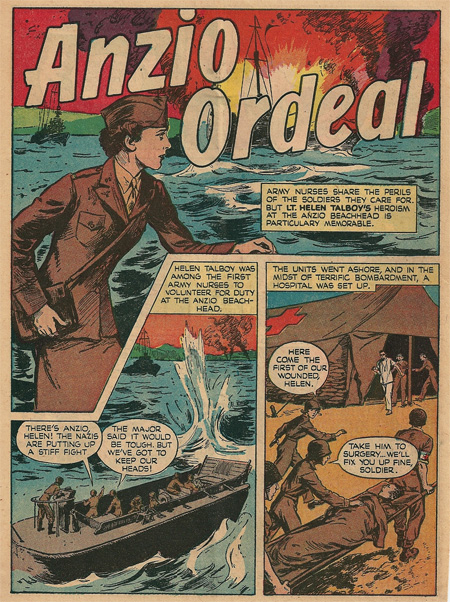
True Comics No. 43, Spring 1945, “Anzio Ordeal”, 2 pages, illustrating Lieutenant Helen Talboy’s heroism on the Anzio Beachhead following the 7 February 1944 bombing.
France:
Participation in “Operation Dragoon”, Allied invasion and landings in Southern France, starting 15 August 1944. In conjunction with “Operation Overlord”, the invasion of France (6 Jun 44), the new objective was to establish a Mediterranean bridgehead and subsequently to exploit towards Lyon and Vichy in France. Forces involved would be both American and Free French with as main target the capture of Toulon, followed by the securing of Marseille, and a general exploitation to the north in order to link up with Allied Forces advancing from Northern Europe. On 2 March 1944, Major General Alexander M. Patch was appointed Commander Ground Forces taking part in Operation Anvil (well-known for the Guadalcanal campaign in the Pacific, and recently CG IV Corps on training duties in the Western United States –ed). Allied Headquarters in Italy notified that all forces assigned to “Force 163” be released at once, starting 15 June 1944.
Prior to the invasion, extensive training had taken place at the Salerno Invasion Training Center. Lectures and instructions in waterproofing technique, amphibious training, vehicle loading and unloading, followed by demonstrations, dry runs, and critiques followed each other. Medical units practiced driving ambulances over an obstacle course, carrying litters under simulated combat conditions, and trained with DUKWs for evacuation of casualties from beach to ship.
All hospitals assigned to the Seventh United States Army for the invasion of Southern France, with the exception of the 51st Evacuation Hospital, had seen service in the Mediterranean Theater. All of the Field Hospitals had the necessary experience and all were augmented by experienced surgical teams from the 2d Auxiliary Surgical Group.
The landing proper was made without opposition. As the landing and the advance proceeded without many difficulties, everything went so rapidly, the 95th only established at its third selected site, being some 25 miles inland, at Gonfaron. Having been assigned to the Seventh United States Army, units continued to leapfrog and advance further north. On 19 August a number of French civilians and FFI casualties were received. The unit’s Nurses arrived the same day on the USAHS “Marigold” and the Principal Chief Nurse, Captain Evelyn E. Swanson had the honor of being the first American woman to set foot on the soil of Southern France. By end of August the 95th was far behind the frontlines and still lacking its transportation (remaining in Italy) impairing any movement forward.
The following move took place on 3 September with the unit spending the night at Beaumont d’Aspres as guests of the 9th Evacuation Hospital. A second night was spent in bivouac at the site of the Medical Clearing Company of the 3d Medical Battalion (3d Infantry Division –ed) as the selected area could not be cleared in time.
The convoy departed the next day, reaching St. Amour at 1230, 5 September, where it started operations after six hours and fifty minutes. The case load was heavy during the first few days not only because the 95th Evac was one of the most forward medical installations but also because patients had to be kept inordinately long owing to evacuation difficulties (railroads were demolished, motor transportation was short and critical, distances were important, fuel and oil supplies were almost non-existent, and bad weather frequently precluded ground and air traffic). The rear detachment, with its trucks, only reached the unit on 7 September 1944, having finally debarked in France, and caught up with the hospital after driving over 450 miles. Air evacuation starting 9 September removed some of the heat.
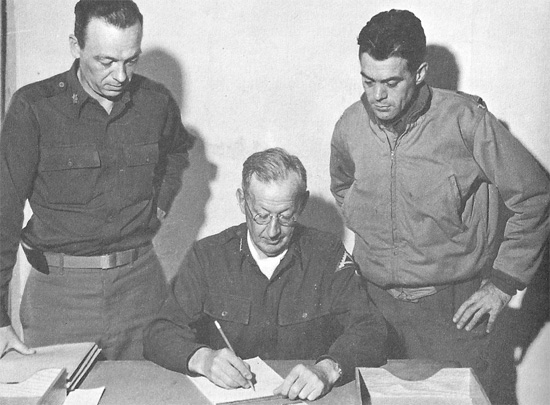
Some Seventh United States Army key medical planners and staff involved in the preparation of “Operation Dragoon”, the assault against Southern France, 15 August 1944. From L to R: Lt. Colonel Robert Goldson (Evacuation Officer), Colonel Myron P. Rudolph (Seventh US Army Surgeon), and Lt. Colonel Joseph Rich (Operations Officer).
After some luxurious life in the land of plenty at Saint-Amour surrounded by wonderful French hospitality, it was time to move to another location, Renauvoid (near Epinal –ed). The site was situated on a grassy slope with good drainage, surrounded by woods acting as a good windbreaker, and bounded by a highway on one side and a good gravel road on the other. This was another installation under tentage, before moving into buildings at Golbey. Due to the changes brought about in personnel strength (amended T/O & E), the organization was forced to hire about 40 civilians mainly used for litter carrying. With the approach of fall and winter, the existing buildings at Golbey lent themselves quite well to a medical installation. Water supply and lighting proved sporadic at first, but within a few days were quite adequate with the help of some engineers. Added generators were however necessary to supply the OR and the X-Ray department. Officers, Nurses, and Enlisted Men had made themselves barely comfortable when instructions were received to make a quick move into some abandoned barracks at Mutzig, France, 74 miles more east. Notwithstanding housecleaning and repairs, the new site was ready for operations 2 days after having closed at Golbey.
During the hospital’s stay in France, a total number of 4320 surgical operations were performed, with only 37 deaths being reported.
Medical Units – “Operation Dragoon” 15 August 1944
2d Auxiliary Surgical Group
7th Medical Depot Company
10th Field Hospital
11th Evacuation Hospital (SM)
52d Medical Battalion
56th Medical Battalion
58th Medical Battalion
93d Evacuation Hospital (SM)
95th Evacuation Hospital (SM)
6703d Blood Transfusion Unit
+
401st Evacuation Hospital (French)
405th Evacuation Hospital (French)
422d Field Hospital (French)
432d Medical Battalion (French)
Stations – 95th Evacuation Hospital
Cavalaire, Southern France – 15 August 1944 > 17 August 1944 (bivouac)
Cogolin, Southern France – 17 August 1944 >18 August 1944 (not operational)
Gonfaron, Southern France – 19 August 1944 > 27 August 1944 (closed awaiting movement orders and necessary transportation 28 – 31 Aug 44)
Beaumont, Southern France – 3 September 1944 > 4 September 1944 (bivouac)
Saint-Amour, France – 5 September 1944 > 17 September 1944
Saulx, France – 20 September 1944 > 6 October 1944 (most forward Seventh US Army Hospital)
Renauvoid, France – 9 October 1944 > 19 November 1944 (officially transferred to ETO 1 Nov 44)
Golbey, France – 20 November 1944 > 2 December 1944 (established in buildings)
Mutzig, France – 6 December 1944 > 31 December 1944 (set up in buildings)
Epinal, France – 3 January 1945 (return to Mutzig)
Sarrebourg, France – 8 January 1945 > 23 March 1945 (set up in buildings)
Surgical Service:
The Officers of the different sections were divided into 5 teams of four men each, consisting of an experienced Surgeon as team chief, with three junior Officers as Ward Officers and assistants. The junior Officers were rotated from team to team at intervals of three or four months, in order to broaden and diversify their operative experience and skills. The teams served as first on call for 12 hours, with another team as second on call. The first team furnished the Pre-operative and Shock Officer plus three men available for the Operating Room; the second team provided the Receiving Officer and three Surgeons for the OR. In practice this meant that a Surgeon was on call for 2 nights, then off for 24 hours, then on for 2 days, and off again for 24 hours. This method provided for adequate rest, even in periods of great activity.
Eight Nurses had been trained in anesthesia, with four of them working on each 12-hour shift.
Most of the battle casualties presented multiple wounds precluding a direct return to duty from the hospital. Wounds of the extremities constituted the greatest number and peripheral vascular injuries were very common constituting some serious problems. Severe infections were observed often related to neglected wounds of the lower extremities such as extensive vascular and/or muscle damage, and the new drug, penicillin, did much to control these infections. The policy was to avoid and restrict amputation as much as possible, unless definite gangrene or extensive anaerobic infections had set in. Having been very fortunate in the French campaign in having an attached Neuro-Surgical Team from the 2d Auxiliary Surgical Group, the surgical department was able to rely on specialists for handling craniocerebral cases and spinal cord injuries with great judgment and skill.
Medical Service:
During spring and summer of 1944, there was a seasonal increase in upper respiratory diseases as well as a sharp upswing in trenchfoot admissions. Although there were over 1078 medical admissions during this period, there were no deaths attributable to medical causes. A small number of hepatitis patients and malarial admissions were noted, probably due to the prophylactic measures instituted by the medical authorities, which in the main consisted of the eradication of malaria-breeding grounds and the distribution of Atabrine. Only 103 VD patients were admitted for treatment, since all such admissions had previously been diverted to establishments set up for the purpose of handling such cases. Not a single case of typhus was noted during the entire stay in Italy.
While in France, malarial admissions reached a new high with 223 cases being admitted to the 95th. During September and mostly because of the weather conditions, trenchfoot made its appearance once more resulting in 407 cases that had to be treated and eventually evacuated to base installations as quickly as possible except those very mild cases that could be subsequently treated at a Convalescent Hospital or returned to duty.
Total medical admissions for 1944 reached 7762, the highest peak being reached in June 1944, with 1247 patients.
Laboratory & Pharmacy Service:
The year 1944 saw the advent of penicillin in war medicine. In April 1944, ten (10) ampules of 100,000 units were used each week. In November, the increase reached 300,000,000 units per week!
In conjunction with the introduction of penicillin, the consumption of sulfa drugs did not diminish. In March 1944, 5,000 Sulfadiazine tablets were consumed each week, and in June, this increased to 22,000, slightly lowering to 18,000 per week next November. The overall use of bank blood increased steadily, although supply was low at times depending upon the weather which prevented the planes from bringing up more blood.
A total of 140 deaths occurred in the 95th Evacuation Hospital during 1944. The Laboratory services performed 14,387 tests during the same year.
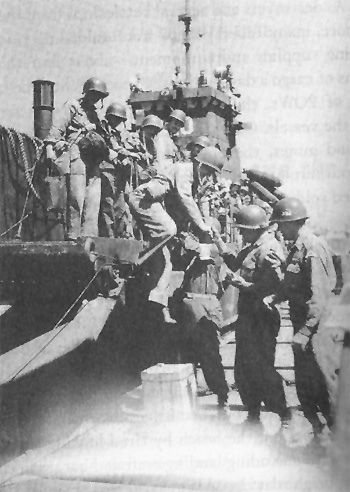
Captain Evelyn E. Swanson, Principal Chief Nurse of the 95th Evacuation Hospital, leaps from a landing barge, becoming the first US Army Nurse to set foot in Southern France, 19 August 1944.
Nursing Service:
In January 1944, the Nurses were quietly informed that another trip was in store for the organization. This meant another period of intense preparation and days filled with excitement and expectations.
On 8 January 1944 the ANC complement left the hospital to take up quarters at the Bagnoli Spas (Terme di Bagnoli), Italy, to await the day when they would embark for a new adventure. During this period, practically all Nurses were sent out on DS to the 21st General Hospital. The one unpleasantness during the stay at the baths was the fact that the Nurses’ living quarters were rather unsatisfactory, all of the rooms being constantly filled with irritating sulphurous fumes (sulphur vapors emanating from natural sources –ed), thus accounting for the ever present smells and vapors. Finally the day arrived to board the LCI that would take them to Anzio and their hospital, the 95th Evacuation. The hospital was set up and functioning in a beautiful small park-like grove at the water’s edge, on the outskirts of Nettuno. The sounds of gun fire, the roar of aircraft, the explosion of bombs and shells, and the fall of ‘flak’ fragments filled the days. As the area proved to be too hazardous, the order came to pack and move. After setting up again, the organization rapidly filled a constant stream of incoming patients. There were baths to be given, dressings to be changed, beds to be made, and patients to calm down during air raids and shellings.
Work continued at full capacity until 7 February 1944 when, during air activity, several bombs landed in the 95th area. This proved to be the major catastrophe in the hospital’s existence, costing the lives of three (3) Nurses, Lieutenants Blanche F. Sigman, Carrie T. Sheetz, and Marjorie G. Morrow. At the same time Miss Ester Richards, an ARC worker and a valued and true friend of the Nurses lost her life too. This was a tragic blow that misfortune dealt the lives of these courageous and loyal women (in honor of her memory, the War Department saw fit to name one of its Hospital Ships, “Blanche F. Sigman” as a tribute to her unselfish devotion to duty). In addition to the above casualties, injuries were suffered by First Lieutenants Ruth D. Buckley and Fern H. Wingerd, Second Lieutenants Mary W. Harrison and Ruby L. Hoppe (both on TD from the 21st Gen Hosp –ed), and Private Wesley Tanner as well as the unit’s Commanding Officer, Lieutenant Colonel Paul K. Sauer. The Nurses conducted themselves in an excellent manner during this crisis. In spite of the tragedy involving their friends and colleagues, they all remained calm giving invaluable assistance to those requiring first aid, relieving those in pain and helping to move and evacuate others to more comfortable places.
As the Germans continued to shell the beachhead the situation remained dangerous. Around 1400 hours, 9 February 1944, Colonel Jarrett B. Huddleston (Surgeon, VI Corps) was waiting outside Corps Headquarters for a jeep when a 170mm shell fell nearby and a large piece of shrapnel struck and killed him where he stood (more hospitals were later hit by enemy long-range artillery –ed).
An order to prepare for a move was issued by Lieutenant Colonel Hubert L. Binkley who assumed command in absence of Colonel Sauer. This was necessitated by the fact that too many of the organization’s key personnel had become casualties, and much of the equipment had been destroyed. Packing and loading took place in the midst of rain and it was with little reluctance that the hospital staff and personnel departed their Anzio ‘home’. After entrucking, the motor convoy drove down “Purple Heart Lane” past the previous Nettuno installation site toward the port area, the one spot favored target of the enemy long-range gun that made life at Anzio so miserable and unforgettable. An LST returned everyone to Naples, the final destination being Riardo, Italy.
Following the receipt of new orders, another move took place, with destination a delightful spot in the vicinity of Carinola where work was light thus offering ample opportunity for relaxation. Some outdoor activities were organized, and a softball team was formed with the Nurses challenging their fellow ANC Officers of the 56th Evacuation Hospital. Tourist trips were scheduled to Capri, Sorrento, Pompei and the Vesuvius.
After May the push for Rome and the relief of troops bogged down at Anzio began, and before long the 95th Evac was functioning again at high speed. Advancing and trying to follow the advancing troops, the 95th crossed the Garigliano River becoming the first Evacuation Hospital to cross the river on the road to the Eternal City of Rome.
The following setup at Itri proved to be one of the shortest in the unit’s history, with days filled with hard work. Then Cori followed, and soon afterwards, the hospital passed through the historical city of Rome to establish at Montalto, Italy. Provisions were made by the Surgeon’s Office to arrange for 3-day trips to visit the city and other historical places. Another transfer was ordered, with the group traveling to Sparanise and rumors abounded of another invasion, but where ? Southern France ? Yugoslavia ? Greece ? It was here that the first wedding among the Nurses took place. First Lieutenant Adeline Simonson was married to Captain Marvin Williams (34th Infantry Division -ed) in a lovely ceremony held in Naples. The trip would provide far better accommodation for the Nurses since they were to travel aboard the Hospital Ship USAHS “Marigold” which had recently arrived from the Zone of Interior. A large variety of food was soon discovered on board with a rich choice of fresh eggs, cereals, potatoes, meat, and vegetables. The PX on board sold large quantities of Coca-Cola and needless to say that this opportunity was embraced by all the Nurses.
The ANC complement finally landed on the French Riviera 19 August 1944, where they were greeted by the CO, Colonel Paul K. Sauer and the American Red Cross official photographer who made a permanent record of their arrival in Southern France. The first operational site was situated in a valley near Gonfaron, and soon after opening the wards were literally packed with patients and the OR was working at top speed. Seventh US Army had begun to make rapid progress and in a relatively short time many units including medical organizations started advancing and leapfrogging. Suitable sites had to be selected first and after moving the organization at times found itself far from the fighting which severely affected the evacuation of patients.
When respite was brief the girls availed themselves of the opportunity for sightseeing and shopping tours. Purchasing French perfume was the order of the day so trips to Marseille, Toulon, Cannes and nearby towns were promptly arranged.
The further trip overland through beautiful and winding mountainous roads slowed down because of the terrain, and somewhat affected the rate of travel. Some sites could not be reached in a single trip, so bivouacs were arranged at Beaumont on 3 September. The convoy reached the site of the 9th Evacuation Hospital early in the evening where it was offered hot showers and hot food, which were much appreciated. The French welcome was sincere. They often went to great lengths to demonstrate their gratitude and appreciation by volunteering to work around the hospital and brought baskets laden with fresh food for the patients as well as the hospital personnel. Diets were supplemented with fried chicken, potatoes, bread, cheese and unlimited quantities of fresh butter. Cooking among personnel proved a great source of evening diversion.
During fall and winter of 1944-45, several new hospital units were assigned to the Seventh US Army. They included the 54th – 66th and the 81st Field Hospitals, as well as the 112th – 116th – 127th and the 132d Evacuation Hospitals. Other organizations directly transferred from the Zone of Interior had unfortunately little training and lacked experience and some professional competence.
Movement to new sites, such as Saint-Amour, Saulx, Renauvoid, and Epinal, were but a repetition of former setups and the routine of preparing to receive patients did not deviate from the customary procedure. The only notable difference was the change of climate, bringing more wind and rain. It converted the area into a sea of mud which made traveling a real hazard. Rain started seeping through tents making sleeping and keeping dry very difficult. While at Epinal, the hospital experienced its first real snowfall!
The US Army Public Relations Office had meanwhile decided to make a film depicting Army Nurses at work in an Evacuation Hospital. Though this inevitably meant extra work, the hospital routine was in no way interrupted. The movie was under the supervision of Miss Dorothy Sutherland the press representative of the Army PR Office who had been attached to the unit since its arrival in France.
With temperature dropping, a new move was carried out with the 95th Evac now being set up in buildings at Golbey where it arrived on 20 November 1944. After cleaning and making adjustments, everyone was glad and happy to get away from the wet and mud of the field, and to be installed in heated quarters. The last move of 1944 brought the hospital to Mutzig, France, a quaint old town in Alsace, and into buildings formerly occupied by German soldiers, American GIs, and now by the 95th Evac Hosp. The buildings differed from the last ones in that they were three-storied structures rendering litter carry up three flights of stars very inconvenient. During this stay, wedding bells were to sound for First Lieutenant Sally Hocutt and Captain Richard Offutt. ARC workers like Miss Jean McNeil and Miss Nancy Gatch expended much time and effort in decorating the mess hall and the tiny church constructed in 1532. The wedding’s festive mood contributed to the coming holiday spirit with everyone looking forward to the pleasures of the planned grand Christmas party. During the Christmas period, food was served (including packages received from home), trees and decorations prepared, patients visited and presents distributed. Some Nurses, Officers, and Enlisted Men even sang carols to the patients in the different wards. On Christmas Day, all ambulatory patients were invited to eat in the EM’s mess hall which had been colorfully decorated for the occasion.
Germany:
Stations – 95th Evacuation Hospital
Bensheim, Germany – 29 March 1945 > 6 April 1945
Kist, Germany – 8 April 1945 > 25 April 1945
Ebermergen, Germany – 29 April 1945 > 21 May 1945
Bretten, Germany – May > June 1945
Major Staff Officers – 95th Evacuation Hospital (1944)
Colonel Paul K. Sauer (Commanding Officer)
Lt. Colonel Hubert L. Binkley (Commanding Officer, replaced Col. P. K. Sauer, wounded in Anzio 7 Feb 44)
Lt. Colonel Grantley W. Taylor (Chief Surgical Service)
Lt. Colonel William Comess (Chief Medical Service)
Captain Harry J. Schneider (Laboratory & Pharmacy Officer)
Captain Mario C. Gian (X-Ray Officer)
Major Lewis A. Imerman (Chief of Dental Service)
Captain Marshall A. Bauer (Chief Anesthetist)
Second Lieutenant Richard C. Seymour (Adjutant)
Captain Evelyn E. Swanson (Principal Chief Nurse)
The organization was officially inactivated at Camp Kilmer, Stelton, New Jersey (Staging Area for New York Port of Embarkation –ed) on 3 December 1945.
Partial Statistics – 95th Evacuation Hospital (Italy)
7899 Admissions + 77 Deaths
150 Receiving Days + 163 Operating Days
Partial Statistics – 95th Evacuation Hospital (France)
119 Admissions + 86 Deaths
119 Receiving Days + 125 Operating Days
Malaria Cases – 95th Evacuation Hospital (Italy)
903 Patients
Malaria Cases – 95th Evacuation Hospital (France)
808 Patients
Hepatitis Cases – 95th Evacuation Hospital (Italy)
122 Patients
Hepatitis Cases – 95th Evacuation Hospital (France)
84 Patients
Trenchfoot Cases – 95th Evacuation Hospital (Italy)
148 Patients
Trenchfoot Cases – 95th Evacuation Hospital (France)
701 Patients
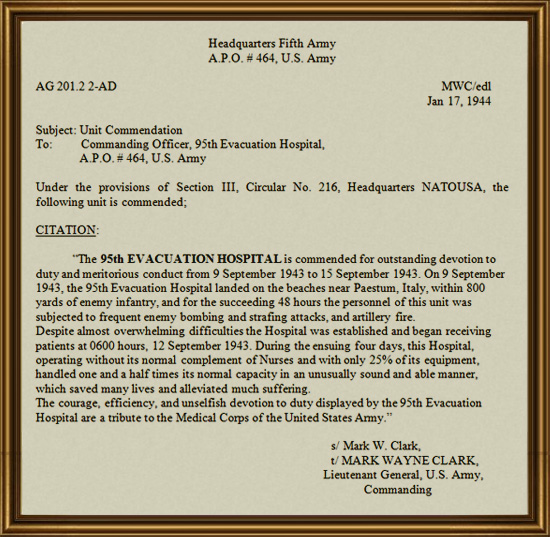
Text of Unit Commendation awarded by the CG Fifth United States Army dated 17 January 1944, for the unit’s devotion to duty during “Operation Avalanche” (Salerno landing).
Awards – 95th Evacuation Hospital
Unit Commendation (Hq Seventh US Army, dated 7 July 43)
Unit Commendation – period 9 September 1943 > 15 September 1943 (Hq Fifth US Army, NATOUSA, dated 17 Jan 44)
Unit Commendation – period 23 January 1944 > 11 February 1944 (Hq Fifth US Army, NATOUSA, dated 10 Apr 44)
Meritorious Service Unit Plaque – period 15 August 1944 > 20 December 1944 (Hq Seventh US Army)
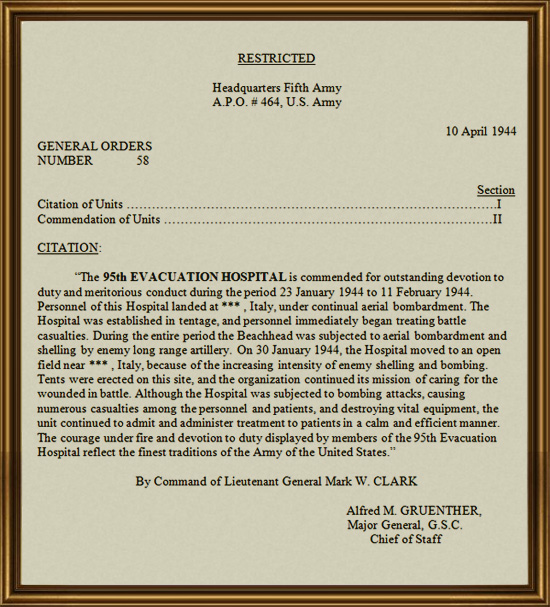
Text of Unit Commendation awarded by the CG Fifth United States Army dated 10 April 1944, for the unit’s devotion to duty and meritorious conduct during “Operation Shingle” (Anzio-Nettuno landings).
Campaign Credits – 95th Evacuation Hospital
Naples-Foggia
Anzio
Rome-Arno
Southern France
Special Note:
ANZIO ORDEAL
First Lieutenant Helen TALBOY, ANC,
95th Evacuation Hospital
It was at Anzio that the Army’s medical units suffered the most casualties: 92 killed, 387 wounded, 19 captured, and 60 reported missing. Four (4) Nurses, Mary Roberts, Elaine Roe, Ellen Ainsworth, and Virginia Rourke, were the first female personnel to be awarded the Silver Star. Six (6) Nurses were killed.
Nurses of the 95th Evacuation Hospital (CO Lt. Colonel Paul K. Sauer) seemed to attract disaster. In addition to being present on HMHS “Newfoundland” (British Hospital Ship, bombed 10 September 1943) when it sank, they were also at Anzio on 7 February 1944, when in an effort to lighten his load to escape a Spitfire, a German pilot jettisoned his load of bombs right over the 95th Evac’s surgical section. Three (3) ANC Officers were among the 26 killed. They were Blanche F. Sigman (Chief Nurse), Carrie T. Sheetz (Asst. Chief Nurse), and Marjorie G. Morrow (ANC Officer).
First Lieutenant Helen Talboy, ANC, (hailing from Des Moines, Iowa), serving with the 95th Evac, was a veteran of the Tunisian, Sicilian, and Italian Campaigns, and also a member of an Allied convoy attacked by enemy submarines, and present aboard the British Hospital Ship HMHS “Newfoundland” (3 American Nurses were wounded, and 6 British Nurses killed) when it was bombed, yet she volunteered for service on the Anzio Beachhead.
When the bombs hit the hospital, Helen Talboy was on duty in one of the surgical wards. The tents were punctured by hundreds of shrapnel holes. Without a moment of hesitation, Helen took charge. She collected the surviving Nurses, helped them to bandages and other medical supplies, and started organizing care and first aid to the wounded. Being the only First Lieutenant left among the 95th’s Nurses, First Lieutenant H. Talboy was temporarily appointed Chief Nurse.
Roster:
Officers:
| Officers: | |
| Sauer, Paul K. (Col) | Lagerstadt, Edward W. M. (Capt) |
| Binkley, Hubert L. (Lt. Col) | Looser, George K. (Capt) |
| Comess, William (Lt Col) | Luce, Henry A. (Capt) |
| Taylor, Grantley W. (Lt Col) | Luskett, Winter B. (Capt) |
| Baxter (Maj) | Lynch, Charles H. (Capt) |
| Courter, Willard O. (Maj) | Malke, Michael C. (Capt) |
| deGrandpré, Arthur B. (Maj) | Matthews, Thomas O. (Capt) |
| Fouche, James W. (Maj) | Musso, Charles (Capt) |
| Gershman, Maurice (Maj) | Payne, Thomas B. (Capt) |
| Imerman, Lewis A. (Maj) | Pellicane, Anthony J. (Capt) |
| Patterson, Howard (Maj) | Riner, Edward D. (Capt) |
| Staples, Oscar S. (Maj) | Schneider, Harry J. (Capt) |
| Truman (Maj) | Shroeder, Al (Capt) |
| Bauer, Marshall A. (Capt) | Stringer, Sydney W. (Capt) |
| Behrens, Charles A. (Capt) | Behrens, Charles A. (1st Lt) |
| Beyer (Capt) | Berent, Raymond F. (1st Lt) |
| Davis, Laurence R. (Capt) | Calhoun, Raymond W. (1st Lt) |
| DeMarco, Silverino V. (Capt) | Haisten, William W. (1st Lt) |
| Ehrlich, Max (Capt) | Hansen, Neil W. (1st Lt) |
| Erickson, Russell B. (Capt) | Heywood, Albert (1st Lt) |
| Friedenberg, Zachary B. (Capt) | Lappley, Walter (1st Lt) |
| Gian, Mario C. (Capt) | Mallon (1st Lt) |
| Gottesman, Joseph L. (Capt) | Stegall, Elbert S. (1st Lt) |
| Gould, Myron N. (Capt) | Seymour, Richard C. (2d Lt) |
| Korda, Henry A. (Capt) | Barbara, Carl P. (WO) |
| Nurses: | |
| Swanson, Evelyn E. (Capt) | Bain, Jessie J. (2d Lt) |
| Anderson, Helen L. (1st Lt) | Benteen, Anita C. (2d Lt) |
| Buckley, Ruth D. (1st Lt) | Duffy, Helen L. (2d Lt) |
| Foss, Anita M. (1st Lt) | Edenfield, Sammy (2d Lt) |
| Fuller, Rosemary (1st Lt) | Fischer, Mary H. (2d Lt) |
| Gosline, Eleanore M. (1st Lt) | Fowler, Edit H. (2d Lt) |
| Hocutt, Sally J. (1st Lt) | Furer, Margaret J. (2d Lt) |
| Joyce, Gladys B. (1st Lt) | Clavey, Ruth C. (2d Lt) |
| McKash, Addid L. (1st Lt) | Gallagher, Margaret L. (2d Lt) |
| Morrow, Marjorie G. (1st Lt) | Hansen, Victoria M. (2d Lt) |
| Pflueger, Emma J. (1st Lt) | Hinckley, Eleanor B. (2d Lt) |
| Ray, Emma G. (1st Lt) | Johnson, Renee L. (2d Lt) |
| Ryan, Mary M. (1st Lt) | Lee, Vera J. (2d Lt) |
| Saari, Senia W. (1st Lt) | MacMillan, Kathryn (2d Lt) |
| Schlemma, Marcella G. (1st Lt) | Marks, Alice (2d Lt) |
| Sheetz, Carrie T. (1st Lt) | Mix, Irene B. (2d Lt) |
| Shelver, Maryjane (1st Lt) | Petersch, Lillie H. (2d Lt) |
| Sigman, Blanche F. (1st Lt) | Rosten, Othelia L. (2d Lt) |
| Smit, Jennette (1st Lt) | Royal, Marjorie A. (2d Lt) |
| Wingerd, Fern H. (1st Lt) | Smith, Lillian J. (2d Lt) |
| Witte, Dora E. (1st Lt) | Sommars, Pauline M. (2d Lt) |
| Zeigler, Anna M. (1st Lt) | Wheeler, Isabelle L. (2d Lt) |
| Enlisted Personnel: | |
| Rojahn, Frank M. (M/Sgt) | Roeder, John D. (Tec 5) |
| Druschel, Frank B. (1/Sgt) | Robinson, Joe M. (Tec 5) |
| Hopkins, Francis M. (T/Sgt) | Rodville, Adolph E. (Tec 5) |
| Jaszkowiak, Dwight J. (T/Sgt) | Rogers, William G. (Tec 5) |
| Pasek, Frank J. (T/Sgt) | Sayban, Andrew (Tec 5) |
| Russell, Richard R. (T/Sgt) | Scharp, Arnold (Tec 5) |
| Studer, Nelson R. (T/Sgt) | Schlerman, Walter A. (Tec 5) |
| Chambers, Robert R. (S/Sgt) | Schuerman, George J., Jr. (Tec 5) |
| Homuth, Ernest J. (S/Sgt) | Schweizer, Lawrence E. (Tec 5) |
| McGlynn, John W. (S/Sgt) | Smith, Frank B. (Tec 5) |
| Randall, Lawrence D. (S/Sgt) | Stockey, Kenneth A. (Tec 5) |
| Sharp, Raymond H. (S/Sgt) | Wray, Fredis A. (Tec 5) |
| Slanker, Robert L. (S/Sgt) | Young, Jeff D. (Tec 5) |
| Titus, William P. (S/Sgt) | Akin, Marion C. (Pfc) |
| Walls, William M. (S/Sgt) | Basham, Arley J. (Pfc) |
| Clague, David L. (Tec 3) | Belcher, Charles E. (Pfc) |
| Coburn, Edgar W. (Tec 3) | Braun, Harold H. (Pfc) |
| Hammerschmidt, Orin D. (Tec 3) | Brennan, William B. (Pfc) |
| Haxton, James W. (Tec 3) | Cope, James L. (Pfc) |
| Horn, William P. (Tec 3) | Costantino, Louis J. (Pfc) |
| Hrebar, Joseph J. (Tec 3) | Davis, James F. (Pfc) |
| Stahlhut, Charles D. (Tec 3) | Dill, Fred E. (Pfc) |
| Guinn, Carl T. (Sgt) | Dotson, Okey F. (Pfc) |
| Konecki, Leonard D. (Sgt) | Fay, Charles P. (Pfc) |
| Landry, Roswell J. (Sgt) | Floyd, Marshel J. (Pfc) |
| Lynch, Louis P. (Sgt) | Gateley, David L. (Pfc) |
| Paxton, Charles T. (Sgt) | Gere, John P. (Pfc) |
| Polanski, Stanley J. (Sgt) | Greene, William H. (Pfc) |
| Thompson, Charles V. (Sgt) | Hater, Jerome G. (Pfc) |
| Baldwin, Raymond G. (Tec 4) | Hilderbrand, Chester W. (Pfc) |
| Boekenek, Casimir S. (Tec 4) | Hover, Lloyd H. (Pfc) |
| Bode, Charles F. (Tec 4) | Jarrett, Edgar C. (Pfc) |
| Brown, Edgar M. (Tec 4) | Kahn, Fred (Pfc) |
| Donnelly, Bernard A. (Tec 4) | Knarr, Alfred R. (Pfc) |
| Faetz, Matthew S. (Tec 4) | Ledakis, Mike (Pfc) |
| Finkelstein, Samuel (Tec 4) | Martin, Ralph M., Jr. (Pfc) |
| Gawlik, Joseph E. (Tec 4) | Mason, Samuel (Pfc) |
| Griffin, George E. (Tec 4) | McCoy, Wilfred (Pfc) |
| Hixson, Willie S. (Tec 4) | Morgan, Kenneth E. (Pfc) |
| James, Thomas D. (Tec 4) | Nesburg, Ralph H. (Pfc) |
| Jewell, Norman C. (Tec 4) | Pederson, Melvin O. (Pfc) |
| Keim, Peter G. (Tec 4) | Pleiman, John M. (Pfc) |
| King, Ralph L. (Tec 4) | Pry, Arthur E. (Pfc) |
| Krause, Robert J. (Tec 4) | Ray, George (Pfc) |
| Kurdys, Raymond J. (Tec 4) | Reamon, Carl A. (Pfc) |
| Lowster, Oliver T. (Tec 4) | Schafer, Harold W. (Pfc) |
| Mantia, Anthony J. (Tec 4) | Sayb, Paul W. (Pfc) |
| Mezek, Harold F. (Tec 4) | Sherbert, Paul G. (Pfc) |
| McDonald, Hershel M. (Tec 4) | Sieuschlag, Ervin F. (Pfc) |
| Moore, Carl O. (Tec 4) | Sims, Millard D. (Pfc) |
| Nowaczyk, John A. (Tec 4) | Slone, Allen. (Pfc) |
| Peterson, Leonard D. (Tec 4) | Stevens, James B. (Pfc) |
| Prince, John J. (Tec 4) | Stewart, Floyd (Pfc) |
| Rakers, Oscar A. (Tec 4) | Tanner, Wesley (Pfc) |
| Rantt, Richard J. (Tec 4) | Tenniston, Chalmer A. (Pfc) |
| Rice, George R. (Tec 4) | Trezze, Joseph J. (Pfc) |
| Sinclair, Charles J. (Tec 4) | Valdez, Fred J. (Pfc) |
| Vance, Carl C. (Tec 4) | Vogelsong Donald (Pfc) |
| Watschke, Robert W. (Tec 4) | Wocher, Carl N. (Pfc) |
| Wray, Walter T. (Tec 4) | Young, George J. (Pfc) |
| Caudle, Everett D. (Cpl) | Arousen, Leif (Pvt) |
| Cooper, William H. (Cpl) | Barker, Basil B. (Pvt) |
| Druck, Donald E. (Cpl) | Baxter, Edgar (Pvt) |
| Galaszewski, Roman L. (Cpl) | Bell, John C., Jr. (Pvt) |
| Halsey, Jesse R. (Cpl) | Bowers, James F. (Pvt) |
| Idoni, Joseph P. (Cpl) | Brady, Keith F. (Pvt) |
| Koenig, James (Cpl) | Cisneros, John M. (Pvt) |
| Kovis, George (Cpl) | Cogar, James L. (Pvt) |
| Long, James L. (Cpl) | Covert, Raymond A. (Pvt) |
| Sandler, Julie R. (Cpl) | Fambrough, Sidney H. (Pvt) |
| Snyder, Orville (Cpl) | Files, Chesley (Pvt) |
| Backensto, Alden R. (Tec 5) | Frederick, Frank D. (Pvt) |
| Donohee, Harold R. (Tec 5) | Goldstein, Joseph (Pvt) |
| Dozier, Clyde W. (Tec 5) | Handler, Woodrow E. (Pvt) |
| Dwyer, Thomas S. (Tec 5) | Harris, LeRoy (Pvt) |
| Esposite, Angelo A. (Tec 5) | Hawkins, James T. (Pvt) |
| Finck, LeRoy E. (Tec 5) | Holt, Leonard D. (Pvt) |
| Foro, Donald (Tec 5) | Jones, James J. (Pvt) |
| Forrester, Eldon H. (Tec 5) | Kentopf, Vernon F. (Pvt) |
| Fort, Samuel E. (Tec 5) | Kimblee, Floyd (Pvt) |
| Fox, Joseph A. (Tec 5) | Layton, Norval E. (Pvt) |
| Gaines, Norman D. (Tec 5) | Lorber, William F. (Pvt) |
| Harris, Elbert M. (Tec 5) | Luoma, William H. (Pvt) |
| Hatzel, John F. (Tec 5) | Meadlin, Paul R. (Pvt) |
| Horwitz, Samuel (Tec 5) | Morris, Harry G. (Pvt) |
| Jarvis, Carl C. (Tec 5) | Moss, Rex J. (Pvt) |
| Jehling, Lester H. (Tec 5) | Neveau, Milton J. (Pvt) |
| Kasmizak, Stanley W. (Tec 5) | O’Hara, John E. (Pvt) |
| Kessler, Hershal C. (Tec 5) | Olinger, Robert A. (Pvt) |
| Killgore, Frederick A. (Tec 5) | Pharo, Norbert G. (Pvt) |
| Kingery, Franklin T. (Tec 5) | Poindexter, Ernest (Pvt) |
| Kacan, Cass A. (Tec 5) | Prater, Millard D. (Pvt) |
| Kurth, Lawrence R. . (Tec 5) | Richardson, Dwight E. (Pvt) |
| Lasky, Leonard (Tec 5) | Roth, Waldo J. (Pvt) |
| Longstreet, Howard E. (Tec 5) | Savage, Jesse L. (Pvt) |
| Mallen, Peter F. (Tec 5) | Seither, Henry G., Jr. (Pvt) |
| McVey, William J. (Tec 5) | Sherbert, Paul G. (Pvt) |
| McWilliams, Robert M. (Tec 5) | Smith, Flaud K., Jr. (Pvt) |
| Mueller, Richard C., Jr. (Tec 5) | Steltemkamp, Harold J. (Pvt) |
| Olsen, Melvin E. (Tec 5) | Tesar, Fred (Pvt) |
| Parnell, Rudolph C. (Tec 5) | Wilczak, Joseph (Pvt) |
| Platt, Robert C. (Tec 5) | Williams, Thomas L. (Pvt) |
Our sincere thanks go to Lynn McNulty, son of Captain Frederick J. McNulty (ASN:O-526873), who supplied the MRC Staff with copies of historical Reports covering the WW2 operations of the 95th Evacuation Hospital. His contributions helped them prepare and edit another concise Medical Unit History. We would also like to extend our sincere thanks to Joyce Moore, daughter of Private Fred Tesar (ASN:38097691) for kindly providing us with a complete personnel roster. We are still looking for reports covering the last days of the Hospital spent in Europe …
